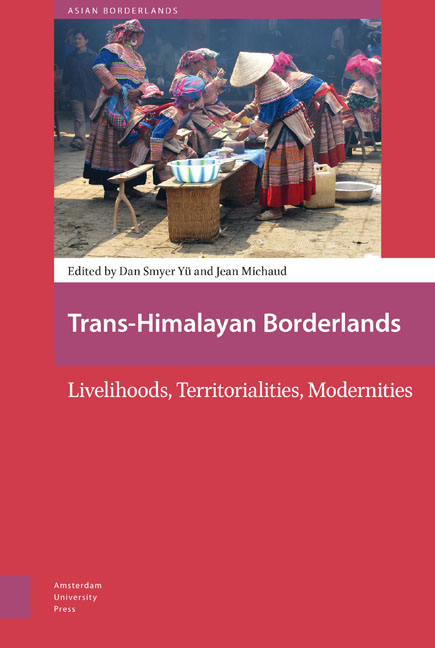Book contents
- Frontmatter
- Contents
- Acknowledgements
- Introduction: Trans-Himalayas as Multistate Margins
- I Territory, Worldviews, and Power Through Time
- 1 Adjusting Livelihood Structure in the Southeast Asian Massif
- 2 The Properties of Territory in Nepal’s State of Transformation
- 3 Trans-Himalayan Buddhist Secularities: Sino-Indian Geopolitics of Territoriality in Indo-Tibetan Interface
- 4 Buddhist Books on Trans-Himalayan Pathways: Materials and Technologies Connecting People and Ecological Environments in a Transnational Landscape
- 5 Seeking China's Back Door: On English Handkerchiefs and Global Local Markets in the Early Nineteenth Century
- II Livelihood Reconstructions, Flows, and Trans-Himalayan Modernities
- 6 Contested Modernities: Place, Subjectivity, and Himalayan Dam Infrastructures
- 7 Plurality and Plasticity of Everyday Humanitarianism in the Karen Conflict
- 8 Being Modern: Livelihood Reconstruction among Land-lost Peasants in Chenggong (Kunming)
- 9 Tibetan Wine Production, Taste of Place, and Regional Niche Identities in Shangri-La, China
- 10 Tea and Merit: Landscape Making in the Ritual Lives of the De’ang People in Western Yunnan
- 11 In-between Poppy and Rubber Fields: Experimenting a Transborder Livelihood among the Akha in the Northwestern Frontier of Laos
- 12 A Fortuitous Frontier Opportunity: Cardamom Livelihoods in the Sino-Vietnamese Borderlands
- Conclusion: Frictions in Trans-Himalayan Studies
- Index
2 - The Properties of Territory in Nepal’s State of Transformation
Published online by Cambridge University Press: 12 December 2020
- Frontmatter
- Contents
- Acknowledgements
- Introduction: Trans-Himalayas as Multistate Margins
- I Territory, Worldviews, and Power Through Time
- 1 Adjusting Livelihood Structure in the Southeast Asian Massif
- 2 The Properties of Territory in Nepal’s State of Transformation
- 3 Trans-Himalayan Buddhist Secularities: Sino-Indian Geopolitics of Territoriality in Indo-Tibetan Interface
- 4 Buddhist Books on Trans-Himalayan Pathways: Materials and Technologies Connecting People and Ecological Environments in a Transnational Landscape
- 5 Seeking China's Back Door: On English Handkerchiefs and Global Local Markets in the Early Nineteenth Century
- II Livelihood Reconstructions, Flows, and Trans-Himalayan Modernities
- 6 Contested Modernities: Place, Subjectivity, and Himalayan Dam Infrastructures
- 7 Plurality and Plasticity of Everyday Humanitarianism in the Karen Conflict
- 8 Being Modern: Livelihood Reconstruction among Land-lost Peasants in Chenggong (Kunming)
- 9 Tibetan Wine Production, Taste of Place, and Regional Niche Identities in Shangri-La, China
- 10 Tea and Merit: Landscape Making in the Ritual Lives of the De’ang People in Western Yunnan
- 11 In-between Poppy and Rubber Fields: Experimenting a Transborder Livelihood among the Akha in the Northwestern Frontier of Laos
- 12 A Fortuitous Frontier Opportunity: Cardamom Livelihoods in the Sino-Vietnamese Borderlands
- Conclusion: Frictions in Trans-Himalayan Studies
- Index
Summary
Abstract
How do Himalayan peoples conceptualize ‘territory’? In English, this concept joins the multiple scales of individual land ownership, communal emplacement in locality, and belonging and ownership of sovereign space at the national level. But how are the links between these different scales envisaged in Himalayan worldviews and languages – if at all? These questions emerge out of my ongoing study of the state-restructuring process in Nepal since 2006 – in which political debates over all three scales of territorial belonging have played an important discursive role. Here I investigate how such political categories are constituted in relation to practices of territoriality at the grassroots level in rural Nepal, both before and after the 2015 earthquakes.
Keywords: Nepal, Himalaya, territory, state transformation, disaster, Politics
Introduction
How do Himalayan peoples conceptualize ‘territory’? In English, this concept joins the multiple scales of individual land ownership, communal emplacement in locality, and belonging and ownership of sovereign space at the national level. But how are the links between these different scales envisaged in Himalayan worldviews and languages – if at all? These questions emerge out of my ongoing study of the state-restructuring process in Nepal since 2006 – in which political debates over all three scales of territorial belonging have played an important discursive role.
These are not new questions for Himalayan anthropology. Several classic ethnographies address these issues for specific linguistic and cultural communities. Place and space have also been major orienting frameworks for multiple strands of analytical engagement with the region over the last few decades. Think, for instance of edited volumes like Himalayan Space (Bickel and Gaenszle 1999), which addresses the relationship between language and terrain; Selves in Time and Place (Skinner, Pach, and Holland 1998), which considers emplacement in the subjective terms of phenomenology; or Territory and Identity in Tibet and the Himalayas (Buffetrille and Diemberger 2002), which explicitly addresses the relationships between territory and identity with reference to anthropological, Tibetological, and comparative religion approaches.
There are also strong, if contested, links between traditions of cultural and political ecology and the Himalayas. This was perhaps initiated in Fredrik Barth's (1965) work on the ‘niches’ that the Swat Pathans and their neighbors inhabited, and followed by the much-critiqued theory of Himalayan degradation (see Ives 1987 for an overview), which linked certain ‘cultural’ behaviors to specific outcomes in land-use change.
- Type
- Chapter
- Information
- Trans-Himalayan BorderlandsLivelihoods, Territorialities, Modernities, pp. 65 - 84Publisher: Amsterdam University PressPrint publication year: 2017
- 1
- Cited by



